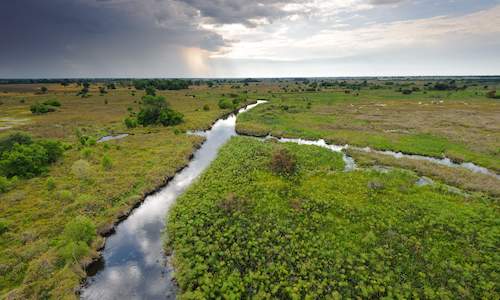
Contributor: Mike Main
Where to go and What to See on your Safari
From his home in Gaborone, Mike Main takes every opportunity he can to explore Botswana's wilderness areas. Eastern Botswana is the area most amenable to agriculture and human habitation. Ancient stone tools and rock paintings reveal that this region has been inhabited for at least 80,000 years.Francistown is the second city of Botswana, primarily a shopping centre with a number of good-value places to stay. South-east of Francistown lie the Lepokole Hills, an extension of Zimbabwe's Matobo Hills, full of caves, gorges and rock-painted overhangs. To the east, on the border with Zimbabwe, is the Tuli Block, including Mashatu (45,000ha of savannah plains, riverine forests, open marshland and sandstone outcrops) and the smaller Tuli Game Reserve.South-west of Francistown lies Serowe, former hometown of Sir Seretse Khama and his wife Ruth. The Khama III Memorial Museum outlines the history of the family and of Serowe, and has a natural history section. 20km north-east is the Khama Rhino Sanctuary, home to White rhino, with plans to introduce Black rhino soon.Rich in wildlife and scenic beauty, north-eastern Botswana includes the Makgadikgadi, Sua and Ntwetwe Pans, the remains of a super-lake that once covered most of northern Botswana. From November, Wildebeest, antelope and Zebra gather in the surrounding grasslands to await the rains that will fill the pans.Millions of birds (notably flamingos) also arrive, sometimes staying until early June. Any journey into the area requires a 4x4, a map and compass, food, fuel, water and vehicle supplies. Some companies offer organised expeditions.The Nata Sanctuary is a community refuge for the wildlife around Sua Pan, where predators, plains game and about 165 species of birds (including Pelicans, Flamingos, Kingfishers, Bustards and Ostrich) have been recorded. Near the south-western corner of Sua is Kubu - a rocky island studded with baobabs and ancient artifacts.Makgadikgadi and Nxai Pan National Park
Makgadikgadi and Nxai Pan National Park, west of Gweta, includes Baines' Baobabs, painted by the Victorian artist and hunter, Thomas Baines. The Nata-Maun road divides the park, which comprises saltpans, grasslands and beautiful mopane- and acacia-studded savannah. It is well populated with game during the rainy season, including Wildebeest, Zebra, Gemsbok, Giraffe, Wild Dogs, Hyaena and Bat Eared Foxes.
Chobe National Park
To the north stretches Chobe National Park, a wild country of flood plain, Baobab, mopane and acacia woodland. The strip north of the Chobe River, with its perpetual water supply, supports the largest numbers of wildlife in the park, while Savuti, Linyati Marshes and the Mababe Depression are also inundated with game (especially elephants) and birds.Kasane is the gateway to the park, situated at the meeting point of four countries - Botswana, Zambia, Namibia and Zimbabwe - and at the confluence of the Chobe and Zambezi rivers. There are numerous places to stay both in Kasane and in the park.
Okavango Delta
The Okavango Delta is arguably Botswana's biggest attraction, a fan-shaped wilderness of channels, lagoons and flood plains covering an area the size of Switzerland. There is a wide variety of wildlife and birds. The best game-viewing months are July-October. The scenic Moremi Wildlife Reserve is superb for a mokoro (dugout) trip through reeds, papyrus and water lilies.At the southern tip of the Delta, Maun offers varied accommodation and most tour operators' head offices. The Nhabe Museum outlines the natural history and culture of the area. The attached Bailey Arts Centre stages theatrical and cultural evenings, and sells local curios and artwork.The wild north-west contains Gcwihaba Caverns (Drotsky's Cave). Gcwihaba means 'hyaena's hole' in the !Kung language and these caverns contain breathtaking stalagmites, stalactites, flowstones and passages. Strong torches and extra batteries are essential - there is no natural light inside.Nearby on the Namibian border are the 700 million-year-old limestone, marble and dolomite Aha Hills. The area is completely barren - no water, mammals or birds, just a few insects and reptiles (notably the barking gecko, after whose call the hills are said to be named).
Tsodilo Hills
The Tsodilo Hills, west of the Okavango panhandle, consist of four rock formations: the Male, the Female, the Child and North Hill. They have been home to the San people for the past 30,000 years and contain over 4000 separate paintings, the Female hill offering the most impressive sightings.The Kalahari
The Kalahari is a vast, silent tract gradually opening up thanks to the new Trans-Kalahari Highway between Gaborone and Windhoek. The Central Kalahari Game Reserve is covered by grasses, acacia trees, shrubs and flowering plants, and was originally established as a reserve for Botswana's San population.
Most people head for Deception Pan, which is packed with wildlife after the rains. Other pans in the reserve, including Piper's Pan and Sunday Pan, receive artificially pumped water for the wildlife. Any journey into this unforgiving area requires a 4x4, sufficient food, water and fuel, mechanical supplies and good maps.

 Game viewing on Botswana safaris is excellent year round. See below recommended Botswana safari tours and lodges in the best Botswana safari...
Game viewing on Botswana safaris is excellent year round. See below recommended Botswana safari tours and lodges in the best Botswana safari...